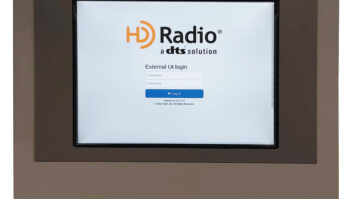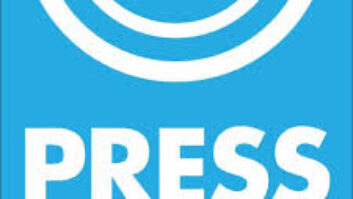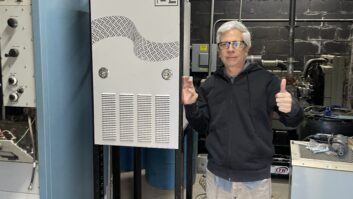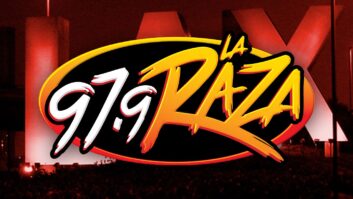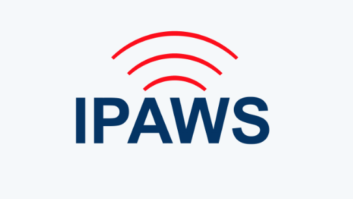FM booster systems (also known as �single-frequency networks� or SFNs) are fairly common around the western part of the country, where VHF reception is made difficult due to the circumstances of terrain. SFNs are in place and in operation in the San Francisco Bay Area; the Santa Clarita area northwest of Los Angeles; and around Seattle as well.
Notas common are HD radio implementations on VHF booster systems.�� There are some built and operating, including the HD radio booster forKCSN(FM), 88.5, at California State University, Northridge. Unlike the Los Angeles stations that have boosters on Oat Mountain to serve the Santa Clarita area, KCSN has its main transmitter on Oat. I asked Mike Worrall, of KCSN Engineering, to give us some background on the system:
�KCSN (a Class B1 allocation, with a high HAAT and a very low ERP) has its main transmitter on Oat Mountain (northwest of the greater LA area.)� The predicted southern end of the 60 dBu contour pretty much follows the I-10 freeway from the ocean at Santa Monica through Mid-Wilshire (downtown LA).� However, the Santa Monica Mountains precludedanymeaningful coverage of this ‘prime listener’ area.� Hence, a Booster was ideally suited to this scenario.� The difficulty was finding a suitable transmitter site for the Booster; most West LA (tall) buildings have rooftop Heli-ports, others will not consider rooftop antennas.� Our first stop was a 13 story building on West Pico Blvd, on the southern end of Century city.� Using a Scala CL-FM vertically polarized array, coverage was ‘marginal to adequate.’�
�The HD radio component came about as part of the CPB’s HD Radio Seed Market campaign of 2004.� At that time, HD radio on Boosters was not allowed by the Commission, and CPB was reluctant to fund our request for HD radio on both the Main and Booster.� Ultimately they agreed, provided we could� 1)� Prove that an RF equipment manufacturer had an exciter that would make HD radio in a Booster environment, 2) Get STA approval from the FCC for HD radio on a Booster and 3) Commit to writing a ‘White paper’ on the results of the HD Booster performance.
��The booster is synchronized to the main Transmitter via the Intraplex�Synchrocastsystem using a two pair of Intraplex T1 multiplexers (“STL Plus with Synchrocast”) which are externally timed with ESE GPS receivers with several high precision options.� The AES audio output from the Intraplex feeds the B.E. FXi 60, which has an optional, outboard ‘pilot sync unit’ which also receives GPS signals to keep the 19 kHz pilot synchronized at both sites. Additionally, the B.E.’s AES audio is calibrated to within 0.1 dB � in other words, the audio modulation level is identical at both sites.
����������������������������������������������� KCSN-FM1 transmission rack

�
Ten years have now passed; what conclusions can be drawn after that amount of time?
�In 2014 we moved to a 27 story building on Santa Monica Blvd, and improved to antenna to circular polarization which substantially improved Booster coverage.�
��������������� Highly-directionalized antenna at new KCSN-FM1 site
�

�From an ‘analog’ perspective the Booster works very well, aided no doubt by the exceptional terrain shielding provided by the Santa Monica Mountains.� There are some areas of mutual interference – the Booster’s ERP is *twice* that of the Main transmitter – so it�s the Booster that actually causes the interference.� KCSN also has a huge co-channel interference issue with KSBR in southern Orange County, so some audible ‘fuzzyness’ in a mobile environment that might be attributed to the Booster is actually a ‘different station’.
How well does the HD booster part of the system work for KCSN, though?�
�To answer that, let me quote from the ‘Conclusions’ section ofJohn Kean’s White Paperon the topic of the KCSN HD booster study:� �In some areas, reliability of HD Radio service was noticeably less than the analog FM quality would indicate.� However, the areas of measured HD Radio reception difficulty tend to correlate with the areas of predicted delay-spread interference… This self-interference cannot be compensated, as HD Radio transmission equipment currently has no provision for offsetting the timing of layer 1 (hardware encoding and modulation) to compensate for signal propagation delay between the primary transmitter and the booster.� Consequently, booster may experience less-than desired HD Radio coverage…�Until Ibiquity Digital develops a means of synchronizing and arbitrarily offsetting Layer 1 timing, caution is advised in the implementation of hybrid FM signal boosters.��
I contributed an article to the February 2013 edition ofRadiothat considered HD radio boosters, should you be interested in learning more about it.





